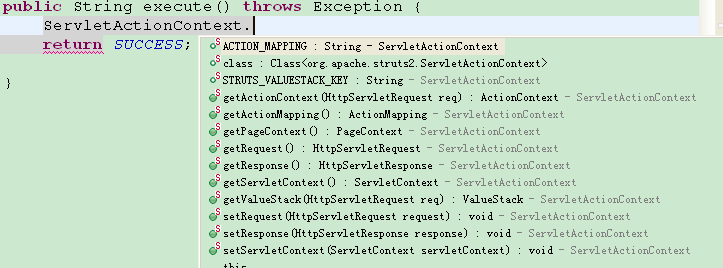在Struts2的Action中取得请求参数值的几种方法 .
先看Action类代码
- public class TestAction extends ActionSupport {
- private String bookName;
- private String bookPrice;
- public String getBookName() {
- return bookName;
- }
- public void setBookName(String bookName) {
- this.bookName = bookName;
- }
- public String getBookPrice() {
- return bookPrice;
- }
- public void setBookPrice(String bookPrice) {
- this.bookPrice = bookPrice;
- }
- public String execute() throws Exception{
- //方式一: 将参数作为Action的类属性,让OGNL自动填充
- System.out.println("方法一,把参数作为Action的类属性,让OGNL自动填充:");
- System.out.println("bookName: "+this.bookName);
- System.out.println("bookPrice: " +this.bookPrice);
- //方法二:在Action中使用ActionContext得到parameterMap获取参数:
- ActionContext context=ActionContext.getContext();
- Map parameterMap=context.getParameters();
- String bookName2[]=(String[])parameterMap.get("bookName");
- String bookPrice2[]=(String[])parameterMap.get("bookPrice");
- System.out.println("方法二,在Action中使用ActionContext得到parameterMap获取参数:");
- System.out.println("bookName: " +bookName2[0]);
- System.out.println("bookPrice: " +bookPrice2[0]);
- //方法三:在Action中取得HttpServletRequest对象,使用request.getParameter获取参数
- HttpServletRequest request = (HttpServletRequest)context.get(ServletActionContext.HTTP_REQUEST);
- String bookName=request.getParameter("bookName");
- String bookPrice=request.getParameter("bookPrice");
- System.out.println("方法三,在Action中取得HttpServletRequest对象,使用request.getParameter获取参数:");
- System.out.println("bookName: " +bookName);
- System.out.println("bookPrice: " +bookPrice);
- return SUCCESS;
- }
- }
总结:
- 方法一:当把参数作为Action的类属性,且提供属性的getter/setter方法时,xwork的OGNL会自动把request参数的值设置到类属性中,此时访问请求参数只需要访问类属性即可。
- 方法二:可以通过ActionContext对象Map parameterMap=context.getParameters();方法,得到请求参数Map,然后通过parameterMap来获取请求参数。需要注意的是:当通过parameterMap的键取得参数值时,取得是一个数组对象,即同名参数的值的集合。
- 方法三:通过ActionContext取得HttpServletRequest对象,然后使用request.getParameter("参数名")得到参数值。
Struts2中Action接收参数的方法主要有以下三种:
1.使用Action的属性接收参数:
a.定义:在Action类中定义属性,创建get和set方法;
b.接收:通过属性接收参数,如:userName;
c.发送:使用属性名传递参数,如:user1!add?userName=Magci;
2.使用DomainModel接收参数:
a.定义:定义Model类,在Action中定义Model类的对象(不需要new),创建该对象的get和set方法;
b.接收:通过对象的属性接收参数,如:user.getUserName();
c.发送:使用对象的属性传递参数,如:user2!add?user.userName=MGC;
3.使用ModelDriven接收参数:
a.定义:Action实现ModelDriven泛型接口,定义Model类的对象(必须new),通过getModel方法返回该对象;
b.接收:通过对象的属性接收参数,如:user.getUserName();
c.发送:直接使用属性名传递参数,如:user2!add?userName=MGC;

转载于:https://blog.51cto.com/2301703/1141686
